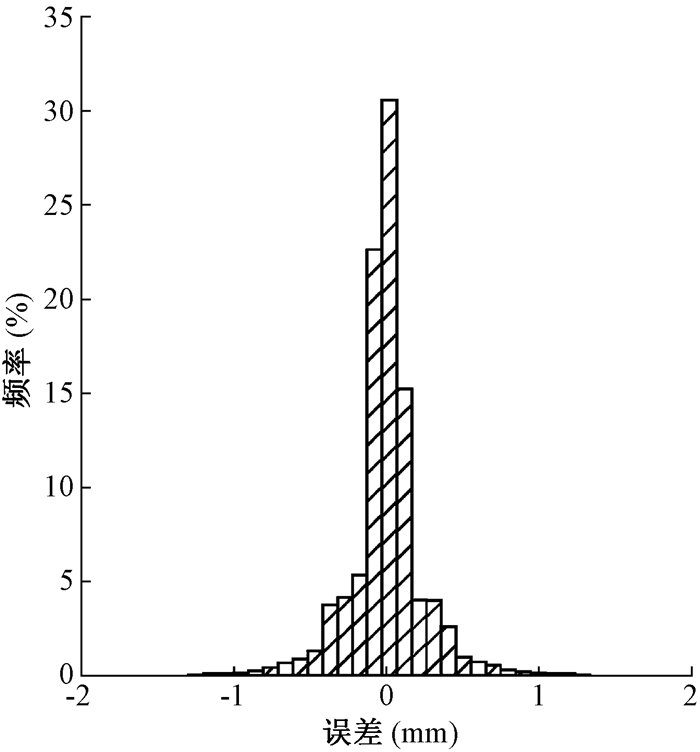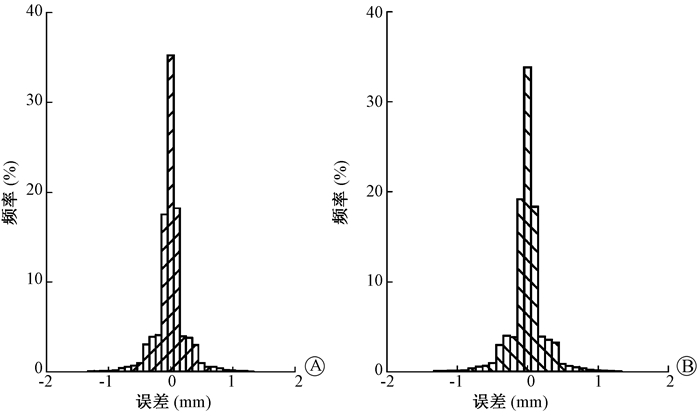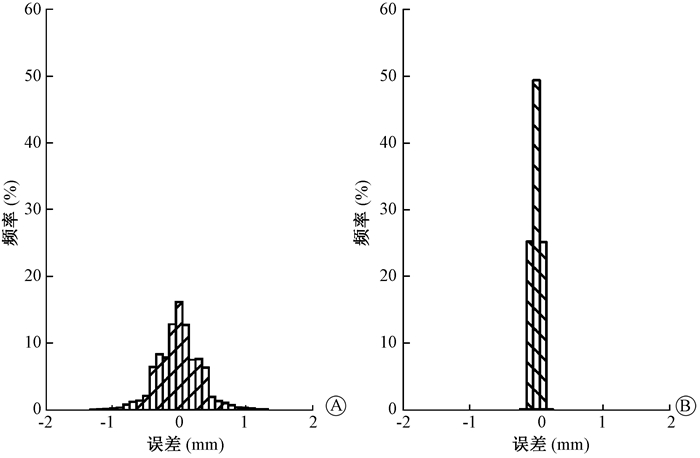容积旋转调强(volumetric-modulated arc therapy, VMAT)通过机架的旋转, 使加速器在出束的同时伴随着剂量率、叶片位置的连续变化, 在保证计划质量不亚于固定野调强技术的前提下, 缩短了照射时间并节省加速器机器跳数, 提高放疗效率, 并具有潜在的放射生物学优势[1-3]。VMAT计划控制点间叶片位置、运动速度受机架转速、剂量率、累积跳数等因素相互制约, 叶片的运动控制更加复杂, 叶片位置误差会直接影响计划剂量分布, 可能会给患者带来不可预知的危险[4]。本研究通过提取并解析加速器记录叶片实际执行位置的日志文件, 分析叶片的到位精度, 监测VMAT计划执行过程中叶片到位情况, 验证一种新的多叶光栅质量控制方法。
资料与方法1.一般临床资料:采用随机数字表法选取山东省肿瘤医院2015年6月至2015年8月收治的32例鼻咽癌患者。
2.计划设计:使用美国Varian公司的Eclipse V 11.0计划系统设计双弧VMAT计划, 采用渐进分辨率优化算法(progressive resolution optimizer, PRO3)。第1个治疗弧(ARC1)机架按181°~179°顺时针旋转, 准直器角度设为15°; 第2个治疗弧(ARC2)机架按179°~181°逆时针旋转, 准直器角度设置为345°。所有患者放疗计划均于实际执行前通过ArcCheckTM剂量验证, 并由Varian Trilogy (RapidARC)加速器执行治疗。该加速器内置MillenniumTM60对多叶光栅(multi-leaf collimator, MLC), 中心区域40对叶片等中心宽度为5 mm, 两侧各10对(共20对)叶片等中心宽度为10 mm。叶片以等中心轴为界对称的分为两组:分别为A和B组, 每组包含60条叶片。
3.叶片位置分析与检测:加速器每50毫安秒检测1次全部MLC端面位置, 并将坐标值记录于动态日志DynaLog文件中。借助美国Varian公司的Argus V 4.7软件解析和提取加速器实际执行计划时记录的DynaLog文件, 该文件实时记录了容积旋转调强计划实施过程中的机械参数, 通过Fortran自编程软件, 解读文件中每个控制点叶片的实际位置, Argus软件同时可以导出计划叶片位置文件, 利用自编程软件对叶片实际位置和计划位置进行比较分析。本研究仅针对活动叶片, 不考虑铅门覆盖下的叶片。为实现计划的个体化验证和叶片整体位置误差分布的检测, 分析的叶片位置信息包括:所有活动叶片的位置误差; 对比A与B组叶片位置误差的不同; 对比ARC1叶片位置误差和ARC2叶片位置误差的不同。每个患者均提取疗程中前3个执行分次的日志文件进行上述误差的分析, 共64个全弧, 每个弧有179个控制点。
4.统计学处理:所有数据结果使用频率直方图显示。差异分析采用SPSS 16.0软件, 对A与B组叶片位置误差的差异和ARC1与ARC2间叶片位置误差的差异分别行配对t检验。P < 0.05为差异有统计学意义。
结果1.所有叶片位置误差频率:所有叶片位置误差频率趋势如图 1所示。误差在±2、±1.5、±1和±0.5 mm以内的叶片占所有叶片的百分比分别为99.99%、99.90%、99.07%和93.98%, 误差范围为-2.95~2.99 mm。

|
图 1 所有叶片位置误差频率 Figure 1 Histograms of leaf position errors for all leaf |
2. A与B组叶片位置误差频率:两组叶片位置误差频率趋势如图 2所示。A组误差在±2、±1.5、±1和±0.5 mm内叶片占该组叶片的百分比分别为99.99%、99.90%、98.97%和94.09%。B组误差±2、±1.5、±1和±0.5 mm内叶片占该组叶片的百分比分别为99.99%、99.93%、99.01%和94.24%。A与B组的叶片位置误差范围分别为-2.95~2.68和-2.92~2.99 mm, 差异无统计学意义(P > 0.05)。

|
图 2 叶片位置误差频率A. A组; B. B组 Figure 2 Histograms of leaf position errors A. A group; B. B group |
3. ARC1与ARC2叶片位置误差频率:ARC1和ARC2叶片位置误差频率如图 3所示。ARC1误差在±2、±1.5、±1和±0.5 mm内叶片占该治疗弧叶片的百分比分别为99.98%、99.84%、98.08%和88.56%。ARC2叶片位置误差均在0.5 mm以内。ARC1与ARC2的叶片位置误差范围分别为-2.95~2.99和-0.22~0.23 mm, 差异有统计学意义(t=2.35, P < 0.01)。

|
图 3 叶片位置误差频率A.第1个治疗弧; B.第2个治疗弧 Figure 3 Histograms of leaf position errors A. The first therapeutic arc; B. The second therapeutic arc |
讨论
VMAT技术通过动态地调整加速器旋转速度、剂量率和叶片位置及速度, 提高了治疗效率[5-6], 技术的复杂性也相应地增加, 在放疗计划方案设计和执行过程中, 随之而来的不确定因素更多, 如计划设计和传输错误、子野序列执行过程中加速器的机械到位误差、机器输出剂量的波动和患者摆位误差等, 都会影响到患者接受的剂量[7-9]。叶片位置决定旋转调强计划每个控制点射野的大小, 如果叶片位置精度不够, 叶片到位误差较大, 导致计划剂量得不到精确投照, 最终会影响放疗疗效, 有可能会给患者带来不可预知的危险, 因此, 叶片到位精度的检测是确保剂量准确投照的重要环节。
加速器叶片到位精度的影响因素主要包括校准程序、射野光野一致性和重力因素等, 这些因素可能会使叶片发生偏移、外扩或者内收等系统误差[10-12]。为保证剂量传输的准确性, 应避免叶片出现位置误差而造成靶区和危及器官受量发生变化[13]。上述几种类型的叶片位置误差对计划剂量分布的影响是不同的, 外扩或者内收的叶片系统误差由于能够明显改变子野面积大小, 该类误差对计划剂量分布影响显著[14]。Oliver等[15]分析了前列腺VMAT计划的等效均匀剂量(equivalent uniform dose, EUD)受叶片位置误差的影响发现, MLC叶片偏移误差对EUD影响为-1.0%/mm, 叶片外扩对EUD影响为8.2%/mm, 叶片内收对EUD影响为-7.2%/mm。在对多叶准直器进行质量控制的过程中应更加注重检测叶片是否存在系统外扩或者内收误差, 本研究通过分析Argus记录的加速器文件可以分析活动叶片的实际到位误差。
Ling等[16]针对执行VMAT计划的加速器叶片的到位精度设计了常规质量控制方法, 加速器在机架旋转速度、剂量率和叶片速度变化情况下投照时叶片到位精度好于0.2 mm, 但加速器执行VMAT计划时叶片有往复、插指等更为复杂的运动情况, 该方法未能给出加速器实际执行旋转调强计划时叶片的到位误差情况。Fontenot[9]利用放疗网络与传输系统Mosaiq对Elekta Infinity加速器执行Pinnacle VMAT计划叶片到位精度进行了分析, 结果显示, 2 mm内的MLC叶片到位误差平均百分比为87.3%。本研究中监测的MLC叶片到位误差在2 mm内的平均百分比为99.99%, 明显优于上述报道结果。研究中提到加速器控制系统与Mosaiq网络记录与传输系统两者在记录叶片位置时存在时间延迟的现象, 可能是导致叶片到位精度较本研究差的原因。
本研究通过分析比较计划文件中的叶片位置与加速器执行计划时叶片的实际位置, 结果显示, 位置误差在±2 mm之内的叶片占所有叶片的百分比为99.99%, 且叶片位置误差成对称分布; A与B组叶片位置误差均为对称分布, 两误差间差异无统计学意义, 该类误差数据分析可以作为检测叶片是否发生系统偏移、内收或外扩的误差依据; ARC2的叶片到位精度好于ARC1叶片的到位精度, 分析其原因可能为计划优化时ARC2的复杂度较ARC1低, 提示在进行多弧容积旋转调强计划验证时, 有必要考虑对各个弧段分别验证, 以便找到可能影响整体计划通过率的弧段。同时, 本方法也可以结合治疗前模体验证的方法对VMAT计划进行综合验证分析, 在VMAT模体验证计划实施的同时采集日志文件, 分析该计划在模体上验证的γ通过率和叶片到位精度, 该方法也是个体化验证的补充。
综上所述, 加速器在执行复杂的鼻咽癌容积旋转调强计划时, 叶片位置在可控范围, 在进行计划验证或者计划复杂度分析时可对每个治疗弧进行分析。日志文件分析可以作为叶片到位精度检测的方式, 叶片位置到位精度的检测符合精准放疗的要求。
利益冲突 本研究由署名作者按以下贡献声明独立开展, 未接受有关公司的任何赞助, 不涉及各相关方的利益冲突作者贡献声明 李成强负责采集数据, 论文撰写, 对结果进行统计和分析; 陶城、朱健、刘同海负责计划制定和数据处理; 卢洁、尹勇设计实验, 指导论文的撰写和修改
| [1] | Otto K. Volumetric modulated arc therapy:IMRT in a single gantry arc[J]. Med Phys, 2008, 35 (1) : 310-317 DOI:10.1118/1.2818738 |
| [2] | Bedford JL. Treatment planning for volumetric modulated arc therapy[J]. Med Phys, 2009, 36 (11) : 5128-5138 DOI:10.1118/1.3240488 |
| [3] | Bortfeld T, Webb S. Single-Arc IMRT?[J]. Phys Med Biol, 2009, 54 (1) : N9-N20 DOI:10.1088/0031-9155/54/1/N02 |
| [4] | Bzdusek K, Friberger H, Eriksson K, et al. Development and evaluation of an efficient approach to volumetric arc therapy planning[J]. Med Phys, 2009, 36 (6) : 2328-2339 DOI:10.1118/1.3132234 |
| [5] | Cedric XY, Tang G. Intensity-modulated arc therapy:principles, technologies and clinical implementation[J]. Phys Med Biol, 2011, 56 (5) : R31-54 DOI:10.1088/0031-9155/56/5/R01 |
| [6] | Rao M, Cao DL, Chen F, et al. Comparison of anatomy-based, fluence-based and aperture-based treatment planning approaches for VMAT[J]. Phys Med Biol, 2010, 55 (21) : 6475-6490 DOI:10.1088/0031-9155/55/21/009 |
| [7] | Wang C, Luan S, Tang G, et al. Arc-modulated radiation therapy (AMRT):a single-arc form of intensity-modulated arc therapy[J]. Phys Med Biol, 2008, 53 (22) : 6291-6303 DOI:10.1088/0031-9155/53/22/002 |
| [8] | Boylan C, McWilliam A, Johnstone E, et al. The impact of continuously-variable dose rate VMAT on beam stability, MLC positioning, and overall plan dosimetry[J]. J Appl Clin Med Phys, 2012, 13 (6) : 254-266 DOI:10.1120/jacmp.v13i6.4023 |
| [9] | Fontenot JD. Feasibility of a remote, automated daily delivery verification of volumetric-modulated arc therapy treatments using a commercial record and verify system[J]. J Appl Clin Med Phys, 2012, 13 (2) : 113-123 DOI:10.1120/jacmp.v13i2.3606 |
| [10] | 白瞳, 朱健, 尹勇. 静态调强放疗中多叶光栅到位精度数字化分析[J]. 中华放射医学与防护杂志, 2014, 34 (11) : 837-840 Bai T, Zhu J, Yin Y. Digital analysis of multi-leaf collimator position accuracy in static intensity modulated radiotherapy[J]. Chin J Radiol Med Prot, 2014, 34 (11) : 837-840 DOI:10.3760/cma.j.issn.0254-5098.2014.11.009 |
| [11] | Clarke MF, Budgell GJ. Use of an amorphous silicon EPID for measuring MLC calibration at varying gantry angle[J]. Phys Med Biol, 2008, 53 (2) : 473-485 DOI:10.1088/0031-9155/52/4/014 |
| [12] | Antypas C, Floros I, Rouchota M, et al. MLC positional accuracy evaluation through the Picket Fence test on EBT2 films and a 3D volumetric phantom[J]. J Appl Clin Med Phys, 2015, 16 (2) : e70-e71 DOI:10.1120/jacmp.v16i2.5185 |
| [13] | Bai S, Li G, Wang M, et al. Effect of MLC leaf position, collimator rotation angle, and gantry rotation angle errors on intensity-modulated radiotherapy plans for nasopharyngeal carcinoma[J]. Med Dosim, 2013, 38 (2) : 143-147 DOI:10.1016/j.meddos.2012.10.002 |
| [14] | 李成强, 陶城, 朱健, 等. 多叶准直器叶片位置误差对鼻咽癌调强放疗剂量的影响[J]. 中华放射医学与防护杂志, 2015, 35 (7) : 544-547 Li CQ, Tao C, Zhu J, et al. Impact of multileaf collimator position errors on simultaneous integrated boost intensity-modulated radiotherapy for nasopharyngeal carcinoma[J]. Chin J Radiol Med Prot, 2015, 35 (7) : 544-547 DOI:10.3760/cma.j.issn.0254-5098.2014.11.009 |
| [15] | Oliver M, Bush K, Zavgorodni S, et al. Understanding the impact of RapidArc therapy delivery errors for prostate cancer[J]. J Appl Clin Med Phys, 2011, 12 (3) : 32-43 DOI:10.1120/jacmp.v12i3.3409 |
| [16] | Ling CC, Zhang P, Archambault Y, et al. Commissioning and quality assurance of RapidArc radiotherapy delivery system[J]. Int J Radiat Oncol Biol Phys, 2008, 72 (2) : 575-581 DOI:10.1016/j.ijrobp.2008.05.060 |
 2016, Vol. 36
2016, Vol. 36


